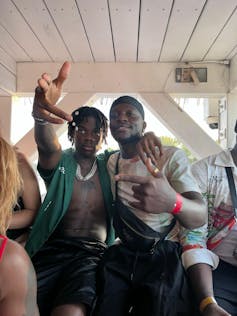
Ananya Jahanara Kabir, King's College London
On 8 March 2023, five teenage girls uploaded on social media a
(Divine Ikubor).The girls were following people across the world who’ve made this dance challenge go viral for over a year by uploading videos of themselves dancing to it. With one difference, though: they were dancing in Iran, where it is forbidden to dance in public, especially without the mandatory headscarves for women.
By 10 March, the 40-second video had gained enough notoriety for the dancers to be rounded up by authorities and made to apologise publicly. But the genie was out of the bottle. Their video is still circulating across social media.
They’re the latest in an escalating series of challenges to the Islamic Republic of Iran, rippling outwards from the death in custody of Mahsa Amini in September 2022. The Iranian woman was arrested for refusing to wear the headscarf in the prescribed manner.
Six months later, Iranian girls are still protesting – but now through a song by an African singer and a dance routine by an African dancer.
A winning combination of music, movement and technology can make dance routines go viral. This was seen, for example, during the COVID pandemic with the South African music and
by Master KG.In popular culture singers are known by name, but dancers largely remain unacknowledged. So who first dreamt up the Calm Down dance that has catapulted from microblogging fame to joyous defiance of a notoriously repressive regime?
The choreography
On 7 March 2022 the now-famous choreography for Calm Down first appeared on the TikTok handle Loïc Reyeltv. The poster was Cameroon-born, Montreal-based Loïc Ngumele Sipeyou, known professionally as Loïc Reyel. He’s the founding director of Afro Vybz dance school and in the video he’s dancing with five students.
Their short routine coordinates expressive hand gestures with footwork drawn from African street dance styles that globally circulate through teachers such as Loïc. Think Ivorian
… These local responses to pan-African electronic music constantly combine with Caribbean and African American dance styles to remember and resist the traumas of enslavement, colonialism and policing of the Black body.
Loïc used these rich resources to interpret a song that had been released less than a month earlier on Rema’s debut studio album Rave and Roses.
In a phone conversation with me, as part of my ongoing research into West African dance forms, Loïc described it as “a very easy song” he “felt immediately connected with” and could “really move to”.
As Calm Down began topping European charts, Loïc’s kinetic response began attracting social media users worldwide. His dance challenge video has, to date, 215,000 likes and 10,500 shares.
Loïc’s video is not just shared; countless people of all ages and nationalities learn his steps, record their performances and upload them on social media. From
between Rema and US singer Selena Gomez gave the song a second peak in September 2022. Meanwhile, Loïc’s dance challenge continues to captivate globally.The song
This magic arises from Rema’s vocal delivery. His melodic genius transforms the popular B major key with a complex progression of chords. The lyrics twist together the recognisable and near-indecipherable. In the song words and phrases like “vibes”, “calm down” and “lockdown” meet the syntax and vocabulary of Nigerian pidgin (“no dey do yanga” and Jamaican dancehall (“shawty”). The fizzy drink Fanta is crafted into an evocative image of desirability (“girl you sweet like Fanta-ooh”). The song pours out like chilled Fanta bubbling up with the unforgettable “lo-lo-lo-lo-ve-ve-ve-ve-ve”. Its laid back approach decolonises the English language, releasing it for the world to use.
Rema’s
increased the song’s appeal by visualising its storyline. His pursuit of a “hot yet humble” girl in her yellow dress draws viewers into urban Africa’s interiors and streetscapes. Its plotline is universal: a couple struggling to emerge from a group. Loïc’s choreography enhances this story. Its hand gestures bring out the meanings swirling around the words. At the same time, legs, waist and pelvis spell out another story: the transformation of African kinetic (movement) codes into street dance styles that became the weaponry of dispossessed youth around the Afro-Atlantic rim.Dance of joy
Says Loïc:
No matter what our people went through in the past, we are always able to dance with joy.
The body’s alegropolitics – its capacity to activate memories of enjoyment as well as trauma by creolising (bringing together) multiple cultural strands – characterises both Rema’s song and Loïc’s choreography. This enhances their interaction as well as, in Loïc’s words, the dance challenge’s “amazing success”. Its unstoppable popularity illustrates what ethnomusicologist Elina Djebbari calls videochoreomorphosis: the processes by which dance, using the body, remains meaningful in the digital age through dancers’ innovative interaction with the music video format.
In responding to Loïc’s challenge, the Iranian girls similarly remake themselves through video. Flamboyantly rejecting cultural isolation for kinetic cosmopolitanism, they step into a dynamic global culture as its active contributors. They flawlessly reproduce the sometimes tricky choreography and they add a special closing note: a spectacular booty shimmy. This runs counter to Islamic-influenced codes of female propriety but draws on the sacred “ontology of the twerk” in Africanist movement cultures.
Dreaming together for freedom
“Dance is freedom,” says Loïc, while acknowledging that these culturally coded moves are often misinterpreted by non-Africans as sexualised. The Iranian girls sense the power of such ambivalence. Looking back while shimmying, and ending with a flamboyant kick towards the lens in classic Afrobeat style, they shift the status quo.
They dance in the massive urban jungle of Ekbatan, a housing project built in Tehran during the 1970s. In the midst of brutalist concrete, hopes blossom through unpredictable confederations.
Rema recently sent a message in response to the video by the five girls:
To all the beautiful women who are fighting for a better world, I’m inspired by you, I sing for you, and I dream with you.
For Loïc, in the meanwhile, the Iranian dancers have confirmed his purpose in life: “to change the world through African dance. I’m closer to my goal.”
With thanks to Loïc Reyel, Francesca Negro and Elina Djebbari![]()
Ananya Jahanara Kabir, Professor of English Literature, King's College London
This article is republished from The Conversation under a Creative Commons license. Read the original article.

